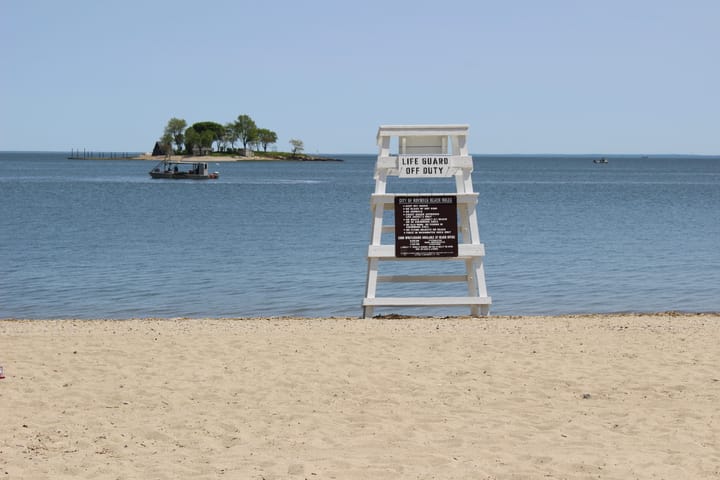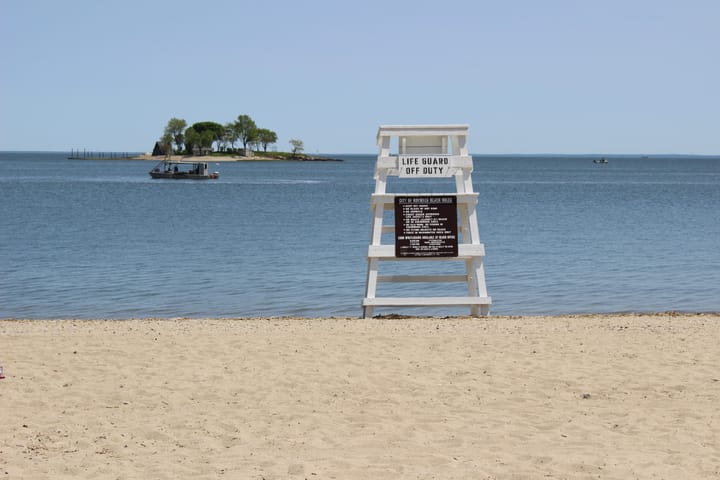How Are Roads Across Southwest Connecticut Paved?
"Paving is a quality of life issue." That's how officials across southwest Connecticut described why the paving process is so important to their communities.
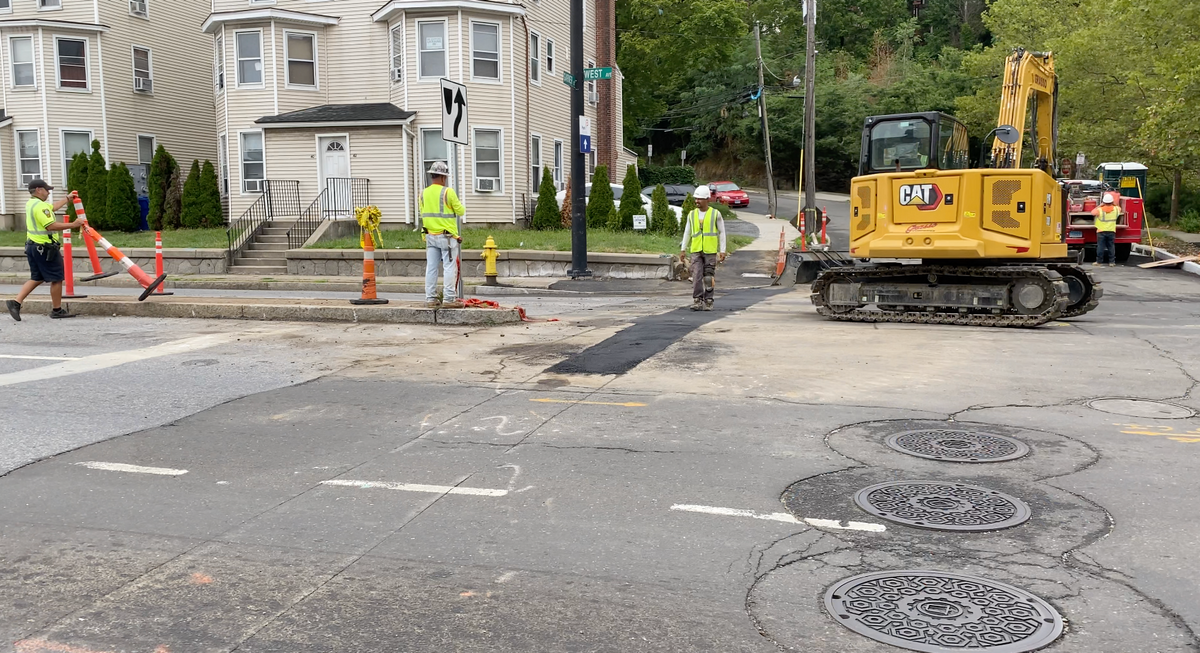
Each day, thousands of people across southwest Connecticut travel on our roads to get to work and school, run errands, or take trips to see family and friends. And one of the biggest challenges they face—whether driving a car, taking a bus, or riding a bike—are rundown roadways, filled with cracks and potholes that can make the trip uncomfortable, stressful, or even costly.
“Paving is a quality of life issue,” said John “Bucky” Marsilio, Fairfield’s department of public works director.
More than 60% of the state’s major roads are in “poor or mediocre condition,” according to a Jan. 2022 report from TRIP, (also called the National Transportation Research Group), a nonprofit that researches, evaluates, and distributes data on surface transportation issues.
“Driving on deteriorated roads costs Connecticut motorists $1.9 billion a year—$728 per driver—in the form of additional repairs, accelerated vehicle depreciation, and increased fuel consumption and tire wear,” according to the report.
Wendy Rogovin, a resident of Stamford, knows this all too well. She and other residents have been asking the city to pave Cove Road for years. Rogovin spoke out at a Board of Representatives meeting in August, telling the board that the condition of the road was “disturbing.”
“Cove Road has become virtually untravelable—driving on that road causes me physical pain. It’s so bumpy and poorly maintained,” she said. “This road is really a disgrace. Those of us in the Cove are really unhappy about it.”
She also told the board that not paving the road was a bit classist and racist as many people of color and people who are economically struggling travel the road to get around daily.
“It’s kind of sad—so I started to agitate to get them to do something because I think they’ve put it off because people are not really bugging them enough,” Rogovin said in an interview.
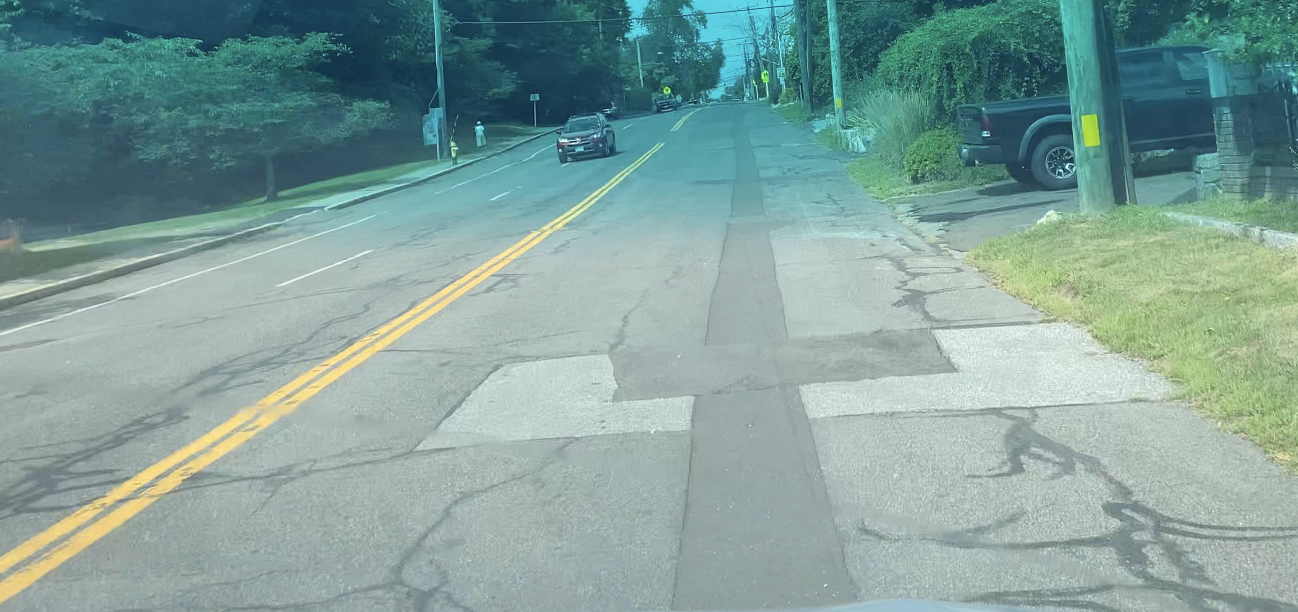
While the city is paving a portion of roadway this year, others across the region aren’t scheduled to be done until at least next season or even longer. With thousands of miles of local roadways in our region, officials say they often get the most calls and complaints related to road conditions.
“We know that one of the top issues we’re facing as a city is our crumbling infrastructure,” Stamford Mayor Caroline Simmons told the Operations Committee of the Board of Representatives in March. “That starts with fixing our roads and our sidewalks. This is something that we hear all the time from residents—I’m sure it’s something you hear all the time from your constituents in terms of the poor quality of our roads and the need to make repairs.”
Maintaining local roadways is one of the most essential services local governments provide, but the process can be more complicated than it initially seems with challenges related to funding, timing, and weather. Paving can be further hampered by the systems local governments have in place to review road conditions and decide what roads get paved. That’s part of why Stamford and Fairfield have recently revamped their paving systems.
Reviewing Road Conditions
Previously, paving in Fairfield was done “anecdotally,” Marsilio said. When he came into the department during the COVID-19 pandemic, he hired a third-party consultant to put together a pavement management program. The consultant went out, drove up and down each road, and captured the conditions of the road before coming up with a report. The roads are ranked green (good), yellow (fair), and red (poor).
Marsilio said the department then used this information to put together a plan with the red roads—and any yellow roads nearby that might become red in a year or two—to address the roads with the most needs.
“This year, we had some glaring needs, some roads that we just knew we had to do—Fairfield Beach Road, and a few other roads—these went to the head of the class,” he said.
Other factors, such as how many cars drive over the roads, also come into play. Rogovin said that’s part of why she is fighting for Cove Road to be paved.
“We get a lot of traffic on Cove Road—definitely people are out and about and it just gets beat up,” she said.
Westport uses a similar system to Fairfield, according to Peter Ratkiewich, director of the town’s public works department. About every three years, the town uses a device that is attached to a van that captures roadway conditions around the town.
“It’s basically a visual evaluation of the road that gets entered into the program,” he said. “This van has all sorts of instruments on it, and as it drives down the road at highway speed, it evaluates the pavement—how rough it is, because it has a vibration monitor on it. It's got an infrared camera that looks at cracking, various different devices.”
All of that information is then compiled and turned into a report, which gives what Ratkiewich calls a “condition index,” rating the stretch of pavement. That index is on a scale of 0-100, which gauges if the road needs more investment or not.
“If we get upwards of 80, we're probably spending too much money on the pavement and not getting its useful life out of it—we're paving too fast,” he said. “If it starts going downward, obviously we're not putting enough in.”
The condition index of the roads is also turned into a map that the public works department uses to see where the roads that need the most work are and that’s how they put together their paving list for each year.
In Darien, Edward Gentile Jr., the director of public works, said that the town is responsible for about 81 miles of roadway, and roads tend to last about 20 years, so they try to pave a little more than four miles of roadway each year.
“So as roads come up to the 20 year anniversary, we evaluate them, and then go out and see if it needs to be put on the list—can it be held over because something else needs to be jumping ahead of it?” he said.
Norwalk Mayor Harry Rilling said the city is currently in the midst of revising how it determines what roads need to be paved.
“What currently the practice is, is to take a section of town and every four years or five years you work in that section to pave the roads,” he said. “We found that that's not the most effective because they would schedule roads that might not need the paving and leave out others that might be much more in need.”
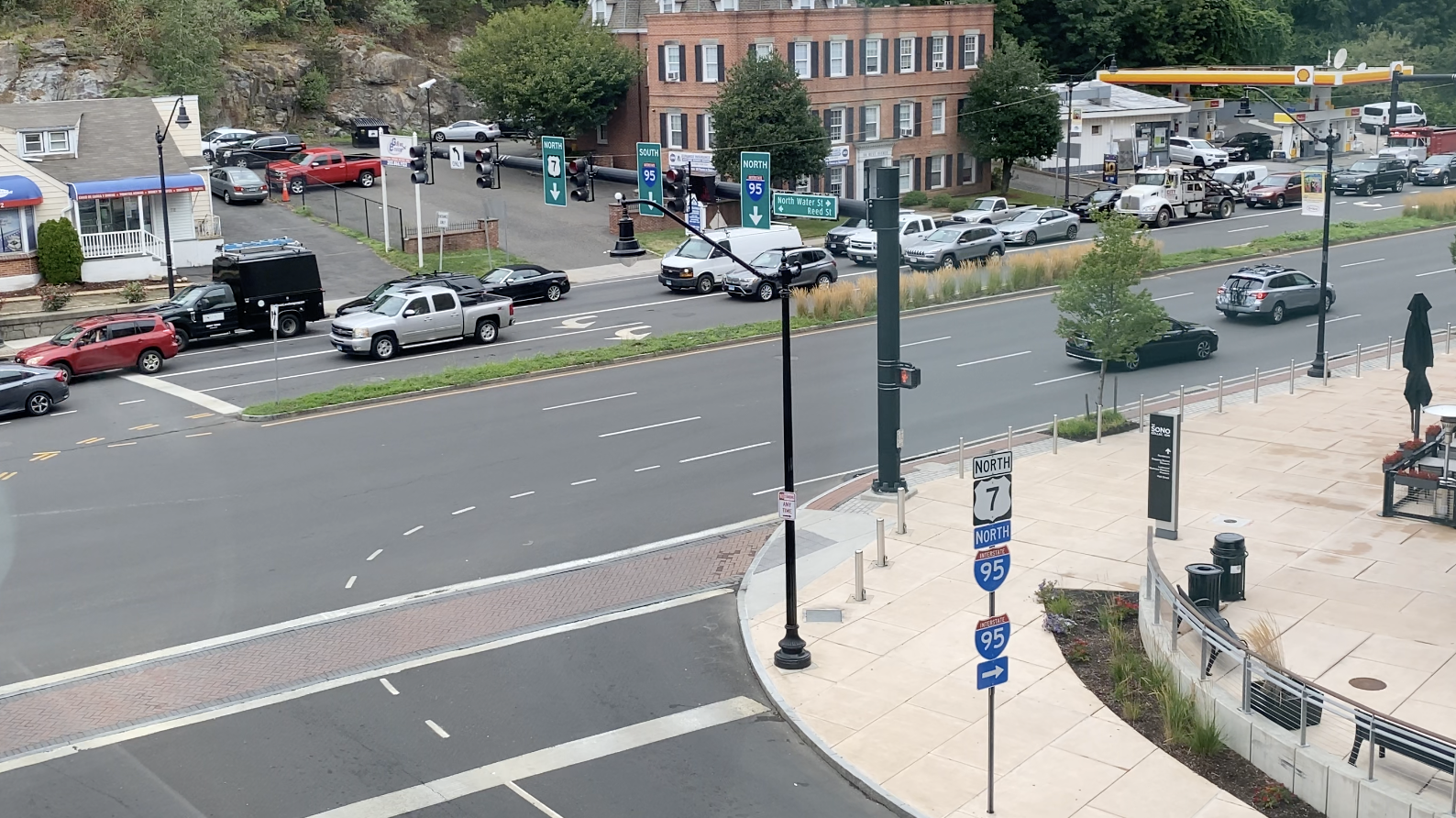
Increasing Output
Earlier this year, Mayor Caroline Simmons announced the launch of Pave Stamford, a new initiative to increase the amount of roadways paved throughout the city.
The main goal of Pave Stamford is to “maximize operational capacity to conduct unprecedented road paving and sidewalk restoration operations.” Simmons said the city is trying to do this using a mix of federal and local funds and also establishing a five-year plan for how roads are evaluated.
Pave Stamford includes four main objectives:
- Develop a two-tier paving schedule for the current fiscal year, which launched in July 2022.
- Develop 5-year comprehensive sidewalk restoration plan for Stamford public schools
- Launch comprehensive city-wide roadway assessment to establish priority paving list for FY23-FY27
- Research the opportunity to integrate unaccepted roads into the city’s future road paving plan
Matthew Quinones, the city’s director of operations, said that their paving schedule for this year includes a list of 43 roads from the prior administration that needed to get paved. The department is then putting together a second list of about 27-30 roads it wants to try to pave this year.
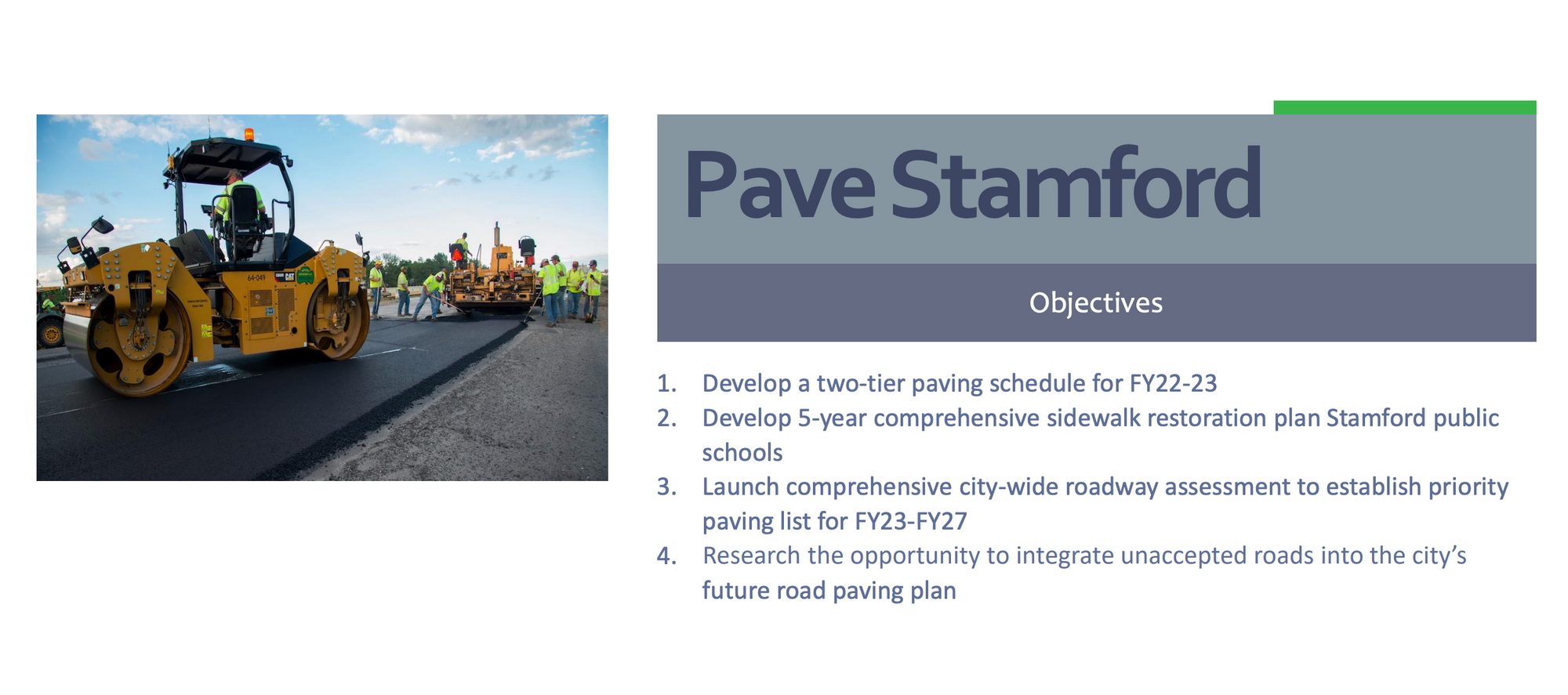
His department plans to use that assessment to create a new priority paving list for future years and “revisit the metrics used to establish that priority list.”
One of the city’s biggest paving challenges is “unaccepted roads,” or roads that when they were built were not engineered to the city’s roadway standards. For example, a cul-de-sac featuring a few houses that was not built wide enough to city standards is considered an “unaccepted road.”
These roads have not been incorporated into the city’s paving plans in the past because they were not “accepted,” and this has left many of them in pretty horrendous conditions,” according to Quinones. There are liability issues involved with this, so Quinones said they’re currently researching this aspect of the plan before taking any official steps.
Simmons said that she hopes this will help the city “pave more roads and improve quality of life” in the city.
Simmons also noted that one of Pave Stamford’s goals is to increase connectivity across the city to make sure that the city is more walkable and easier to get around.
“It’s also a quality of life issue for residents who are spending money repairing their tires when they drive over a pothole, and it's a public safety issue,” she said.
In Norwalk, the city has been trying to coordinate additional improvements to the roads and adjacent areas when roads are due to be paved, such as putting in a bike lane or also fixing the sidewalks.
“We want to make our city pedestrian, and bicycle friendly, and help people navigate safely around the town,” Rilling said. “So we want to just make sure that wherever sidewalks are needed, especially in our Safe Routes to School program, we want to make sure that the people have a safe place to walk.”

